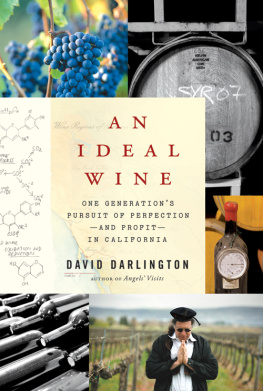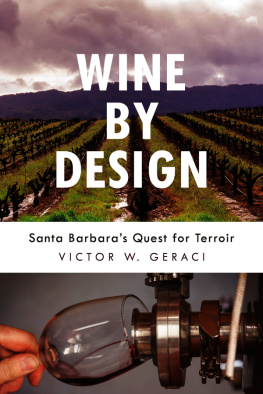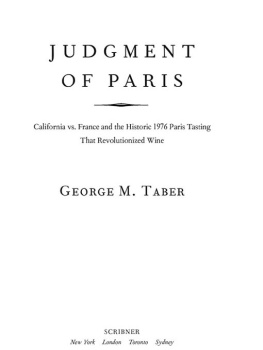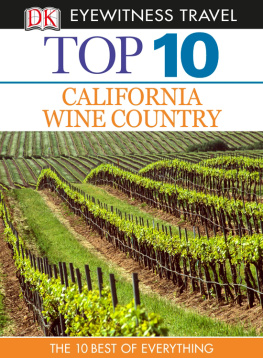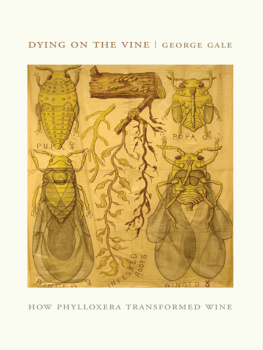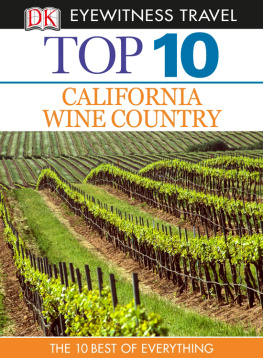An Ideal Wine
One Generations Pursuit of Perfectionand Profitin California
David Darlington

www.harpercollins.com
This book is for two people,
without either of whom it would not have been possible:
Bill Strachan and Joel Peterson.
The wine is juicy, vines are wood,
The wooden table gives wine as good.
Profound insight! Now you perceive
A miracle; only believe!
MEPHISTOPHELES , Goethes Faust
(Walter Kaufmann translation)
Contents
As this book was going to press (what an old-fashioned term), a bombshell burst over the world of wine when Robert M. Parker Jr., founder and preeminent voice of the Wine Advocate, announced that, as of February 2011, he would no longer review California wine. Though hell continue to critique older vintages, as well as new wines from Bordeaux and the Rhne, Parker said he was turning over the contemporary California duties to Antonio Galloni, who also evaluates Italy, Champagne, Burgundy, and Chablis for the Advocate .
In other words, Parkers 100-point scoring system will continue to dangle over the heads of American winemakers, though at this point its hard to envision Galloni (or the less personal authority of the Advocate ) carrying the same weight wielded by the creators notorious surname. Hence, the change has been heralded as the end of an eraan epoch that happens to be chronicled in this book.
In that light, readers holding half-empty wineglasses might be tempted to regard parts of An Ideal Wine as pass. Au contraire. To a large extent, this is a work of historya portrait of a place and time. Now even its present-day scenes, which would inevitably have come to seem dated, have acquired the same hindsight that characterizes the more plainly retrospective parts, circumscribing the whole as a window on a well-defined period. If, as the saying goes, journalism is the first draft of history, Parkers exit imposed an unanticipated deadline, closing the book on a much-declaimed chapter in California wine.
That said, it would be folly to suggest that, with his departure, American vintners are now free to pursue the muse unfettered. Regardless of Parkers priorities, the Wine Advocate , Wine Spectator , Wine & Spirits , Wine Enthusiast , and numerous other point-wielding publications will continue to affect winemakers sleep, no matter which regions feel the heat of the papal palate most directly. All of which calls into service another trusty proviso: The story youre about to read is true. Only the names of some of the characters may have been changed.
L ateSeptember: the autumnal equinox. A predictably perfect Northern Californiaautumn afternoonsunny, warm, windless, and crowned by a clear blue sky. Thanksto a premature spring that inspired grapevines to bud out early, the wineharvest is already winding downeven cabernet sauvignon, one of the lastvarieties to ripen, has mostly vanished from the vines.
With the smooth-jazz trumpet of Chris Botti on hisCD player, Leo McCloskey pilots his Mercedes C230 north into Napa Valley.Wearing his customary warm-weather wardrobeloose-fitting pants, shoes sanslaces, short-sleeved shirt unconfined by a belthes on his way to Chappellet, a25,000-case winery on the Valleys eastern edge.
Flipping open his cell phone as he drives,McCloskey calls a client in neighboring Sonoma Valley. Im looking at yournumbers, he says. Theyre pretty beefy. You need at least 50 percent as aFour; if you have that at midferm, youre already there. I think drain-downsweet is the name of the game this year. Lets do what they do at Lafitecomeout of the fermenter shy of tannin, and later well add tannin. We can also seewhat happens if we play with the oak treatment on one of the wines. I want toencourage you to move more aggressively than you normally would. Thats myjob.
The winemaker on the other end tells McCloskey thatone of the winerys cabernet vineyards still hasnt been picked. Are youtasting the velvety characters that happen just before raisining? McCloskeyasks. Thats good! You know how youre looking for those ripe, plummy flavors?Youre getting them by delaying.
He listens for a few seconds more. Youre golden,McCloskey says. Beautifulyou got a statue in the quad. Hey, I gotta fly.
He pushes the red button on his phone. If yourein Sonoma and your benchmark is Napa or Bordeaux, you have to rearrange MotherNature, McCloskey explains. You have to adapt your winemaking to match thebeauty of Napa and Bordeaux. Napa cabernet is the only New World wine rulerthats being used internationallyit wins price, volume, and scores. The reasonits the market winner is because the word Napa is abrand. Sonoma is an also-ran.
McCloskey turns left on the Silverado Trail,entering the Stags Leap growing district, one of Napa Valleys most prestigiousappellations. They picked too early, McCloskey says, gazing at acres ofgrapeless vines receding from both sides of the road. We have a weekly onlinebulletin that tells people when to pick. On September thirteenth we said not to,and people who picked anyway drained down at 87.1. We said, We told you so.
This advice was based on grape samples thatcustomers had sent to McCloskeys company, Enologix. Upon receiving the fruit,the lab staff treated the juice with solvents and, using a high-performanceliquid chromatograph, measured a selection of its secondary chemical compounds.The resulting figures were entered into a computer that, using software thatMcCloskey developed, compared the projected wines chemistry with that of anideal digital cabernet. The outcome was a quality index that translated intoa critical score of 87.1 (on a 100-point scale) if all the grapes were pickedthat week.
My system divides wines into two tiers, McCloskeysays. Either youre across the 90-point line or youre not. Last year theaverage picking date was September twenty-fifth, but we predicted that the90-point break wouldnt be crossed until October twenty-first. Jim Laube[California critic for the Wine Spectator ] justreviewed that vintage; he called it spotty, like 98. But my customers hadflavors that turned from herbal to plummy. They made fabulous wine.
McCloskey turns right onto California Highway 128,heading east into the oak- and pine-covered hills. The conventional wisdommakes 85-point wine, he says. My thinking is in tune with Laube, Robert Parker[of the Wine Advocate ], and [the noted winemakingconsultant] Helen Turley. Its gratifying to see that were all on the samepage.
Some might suggest that this book has too-fewpages. Such curmudgeons would observe thatowing especially to the influence ofParker, who has been called the planets most powerful critic of any kind, inany fieldwines all over the world have been getting more and more homogenous,merging into a plummy, velvety International Style, free of the astringenttannins that can make wine taste tough or bitter, but devoid of a sense of terroir or regional distinctiveness, the mostcelebrated goal of winemaking. Other than his penchant for superripe grapes(hence, high-alcohol wine), Parkers most lamented influence is hispopularization of the 100-point rating system now employed by most magazines andother wine-evaluation organsmost prominently the WineSpectator, Parkers comaven in market molding. The so-called Scorehas been called Americas main contribution to the wine business: a democratic,no-nonsense way of slicing through the elitist jargon that obscures quality fromthe consumer. Its also maligned as an insidious influence that makes mindlesspuppets of wine buyers, enables anointed wineries to command prices that onlythe rich can afford, and turns vintners into sycophants seeking the favor ofkings Parker and Laube. At the upper end of the market, a thumbs-up orthumbs-down from the Spectator or Advocate can make a big difference in the price of abottle; at the boutique-start-up level, it can spell survival or oblivion.
Next page
